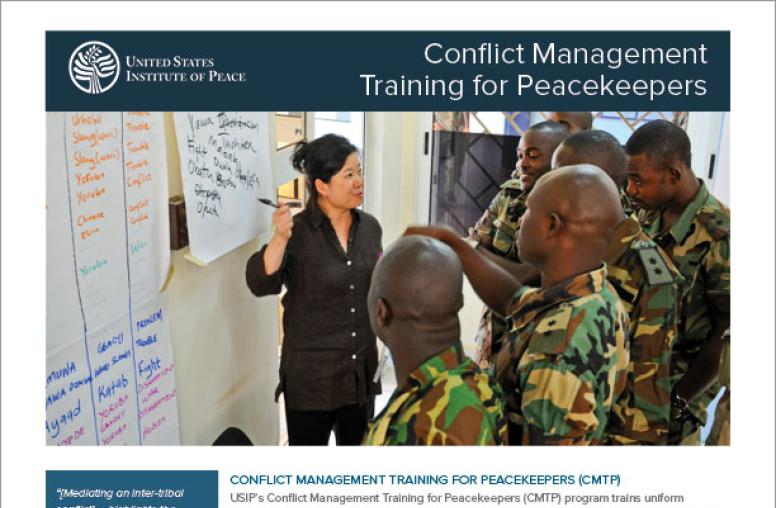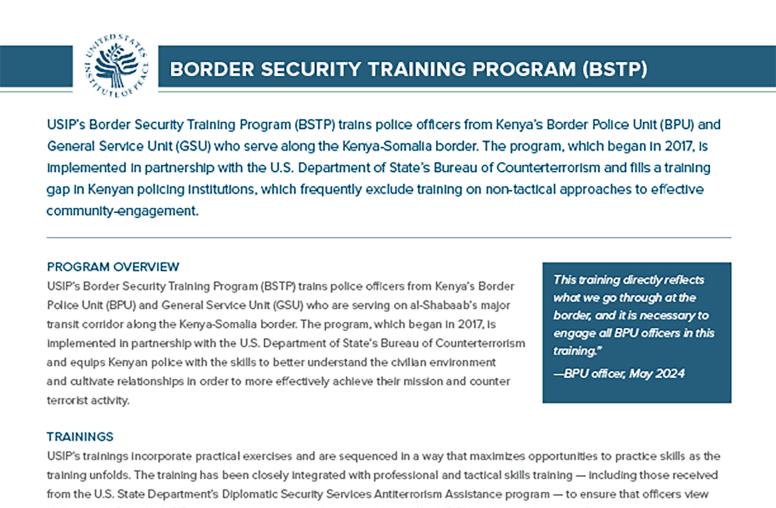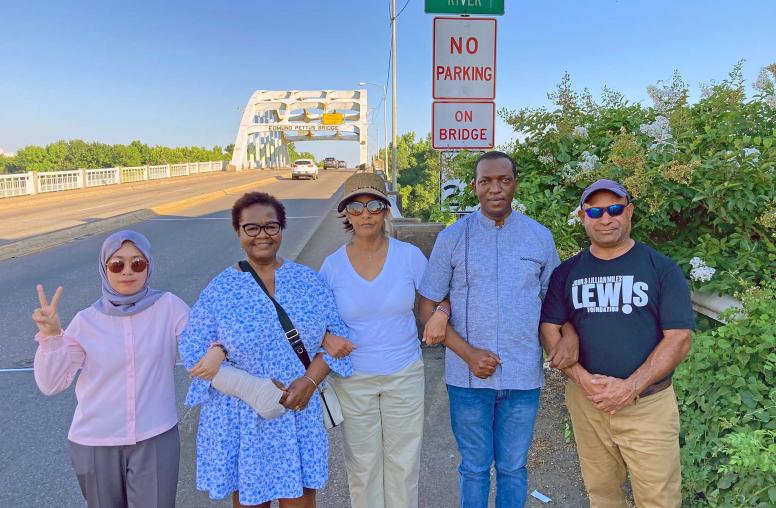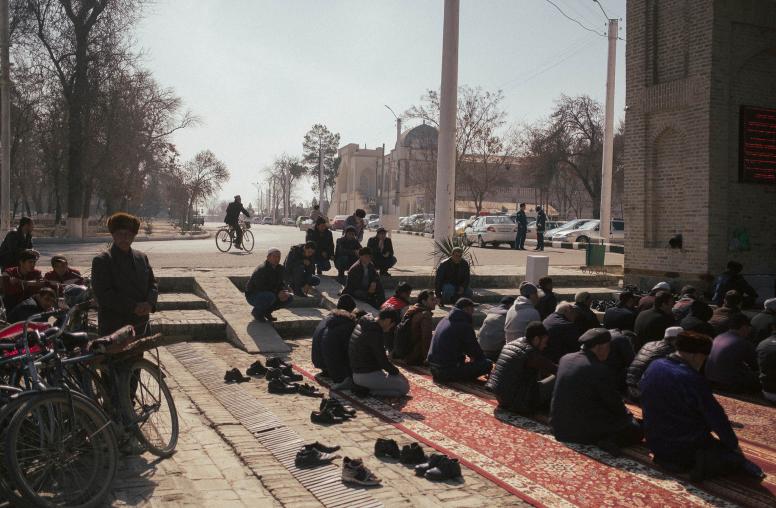Megan Chabalowski on USIP’s Peace Teachers Program
Young people are hungry for examples of people working for peace in some of the world’s most violent conflicts, and they are curious about ways they too can make a positive difference. Megan Chabalowski explains how USIP’s Peace Teachers Program provides educators with the in-depth training and resources needed to incorporate peacebuilding into their classrooms and communities.
On Peace is a weekly podcast sponsored by USIP and Sirius XM POTUS Ch. 124. Each week, USIP experts tackle the latest foreign policy issues from around the world.
Transcript
Tim Farley: At the United States Institute of Peace, they have just concluded the latest edition of the Peace Teachers Program, which is a year-long professional development program for secondary school teachers from across the United States. We wanted to learn more about the program and give you a sense of what they've been doing. Joining us now to discuss it is our guest, Megan Chabalowski, United States Institute of Peace public education program officer. Twitter handle is @USIP.
Tim Farley: Megan, welcome. Thanks for being here.
Megan Chabalowski: Hi. Thank you, Tim, for having me this morning.
Tim Farley: What is the Peace Teachers Program?
Megan Chabalowski: Sure. The Peace Teachers Program is, as you said, a year-long professional development program for secondary school teachers across the U.S. It is a chance for a small group of teachers to work very closely with us at the U.S. Institute of Peace and with each other over the course of a school year as they learn how to integrate really critical issues of conflict and peace and practical peace-building skills into their classrooms. It is an opportunity for them to develop their own knowledge about these important concepts and skills, to build connections with other educators who are like-minded, but also to have some new perspectives, and then to serve as informal ambassadors to this type of education with their colleagues in their communities.
Tim: Alright. The 2018 has just concluded now that we're into 2019, and you work with teachers from Chelsea, Alabama, Franklin, Tennessee, Hartford, South Dakota and Silverdale, Washington, and this next launch next week will include teachers from Alaska, Nebraska, Kentucky and Mississippi. How do you pick the teachers and the schools?
Megan Chabalowski: We're really excited. Each year, we expand to new states across the U.S. The goal is to continue carpeting the country, and so we select teachers based on their demonstrated interest in teaching this kind of content and these skills. They do apply, and then they're selected based on their interest and based on what they think they could accomplish in this program. We're thrilled with the teachers we just concluded the program with, and we're really excited to work with these new states next year.
Tim Farley: What do you teach?
Megan Chabalowski: What do we teach? Good question. We teach the basic peace-building skills that the U.S. Institute of Peace teaches overseas, as well. These are skills of conflict analysis, mediation, negotiation. These are skills that we think are really important for students to learn in the classroom, so our teachers develop an understanding of these skills themselves, so that they can then teach them to their students. But, then they also learn how to connect these skills personally, so that their students are learning what they look like in their own lives to what's happening around the world.
Megan Chabalowski: Our teachers learn about peace-building efforts, particularly USIP's peace-building efforts, but also others who are building peace in some of the most difficult places, and they learn examples of peace-building that they can bring back into the classroom to show how what students are seeing locally and the skills that they're developing personally also translates globally. So, they can see, for example, what mediation might look like in their own life and then what mediation looks like overseas in some conflict areas. They're learning and developing–go ahead.
Tim Farley: What do you do, like how to bring peace with negotiations in your household, first start small?
Megan Chabalowski: Yeah, exactly. One of the challenges always that we hear from teachers is how to help students really connect with this material, to connect with what's happening around the world. You do that by starting with the personal to help students really see what this looks like in their own lives and to really break it down and give them some concrete examples and skills, and then they can begin to see how it applies elsewhere around the world. It makes it more real for them, and it also gives them a sense of how people can actually begin to resolve some of these conflicts that seemed like they might be intractable. It gives them a sense of concrete skills that could use but also that those who are working in these countries can be using to actually begin to build peace.
Tim Farley: Again, Megan Chabalowski's with us, United States Institute of Peace, the public education program officer, talking about the Peace Teachers Program.
Tim Farley: What is the level of, I guess, involvement and understanding in terms of the kinds of problems around the world? It's kind of a joke, really, when you think about the, what do you want, for the Miss America or whatever these beauty pageants? Well, peace on Earth. But, how do you really take somebody through the step-by-step and understanding, not just peace in the context of a domestic, but an international perspective because, obviously, the issue around the world is much more complex than what we are just seeing in our day-to-day lives.
Megan Chabalowski: Great question. We hear from our teachers that what really helps them is breaking down first the concept of peace. And, in fact, this is something that our teachers just chatted about in their public event at USIP last week, that what really helped them and their students was to have a conversation around what peace really means because peace, in itself, is sort of an abstract term. But, once you can make it more concrete by thinking about what does peace actually mean to you as a student and then looking at what peace might actually mean to others around the world, you begin to be able to see how it's a process, that these are actually, there are active steps you can take to build peace. Whether it's providing security for people or whether it's working on stable governance or the rule of law, there are steps you can take to actually begin to build peace. Beginning to even just define it itself is a great first step.
Megan Chabalowski: Then, as I said, it's these skills, and when students really get a sense of how these skills come into play in helping build peace, then they begin to be able to see how you can actually begin to resolve some of these issues.
Megan Chabalowski: A great example is from one of our teachers from Washington, our teacher, Jennifer, from Washington last year, who had her students both look at these peacebuilding skills in their personal lives, so they role-played active listening, dialogue to gain new perspectives, negotiation, mediation, so they began to see how it might look like in their own lives. And, then she challenged them to look at some of the conflicts that are taking place around the world, in which the U.S. is actively involved, and had them think about, in an ideal world, how would they actually begin to address these conflicts? How could the U.S. play an active role in building peace? They were able to use and apply these skills that they had learned to these very real, very serious current conflicts that are happening now and begin to come up with some ideas of resolution. Jennifer said that it was actually a really powerful and empowering experience for her students. Actually, by the end of the year, they really saw themselves as part of this peacebuilding process.
Tim Farley: Before we leave, I wanted to ask, and I probably should have asked in the beginning, how long has this program being going on, and have you seen any of those students who were exposed to it move on to be a part of the kind of peace-solving initiatives that you were just discussing?
Megan Chabalowski: Yeah. We are entering its fifth year, so most students are still in school, there's some are now in college. Yes, in many ways, what is really exciting about this program and the teachers who are in this program is that they are active learners, so they see their time as a peace teacher as just the start, and so they take this content and they continue to teach it over the years. And, they report that their students really come back to it. Each year, they do more. Students get very involved in the International Day of Peace every year and do some big activities around their school and in their community. And, teachers really do report that it begins to also change the dynamics, that students are really taking these skills, and they hear them repeating the vocabulary every day in everyday life and talking about putting these skills into action themselves even once they leave the classroom. It's really exciting to see it take root.
Tim Farley: Megan, thank you so much for joining us today.
Megan Chabalowski: Thank you so much for having me.
Tim Farley: They've been planting the seed. Megan Chabalowski, United States Institute of Peace, public education program, discussing at the United States Institute of Peace the Peace Teachers Program, which is just about to start its next iteration. The Twitter handle is @USIP.



